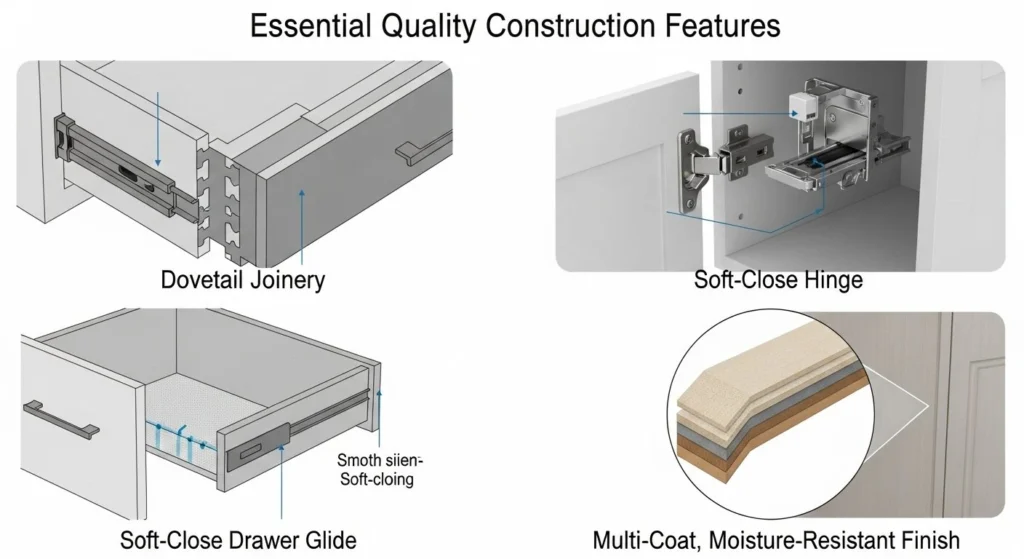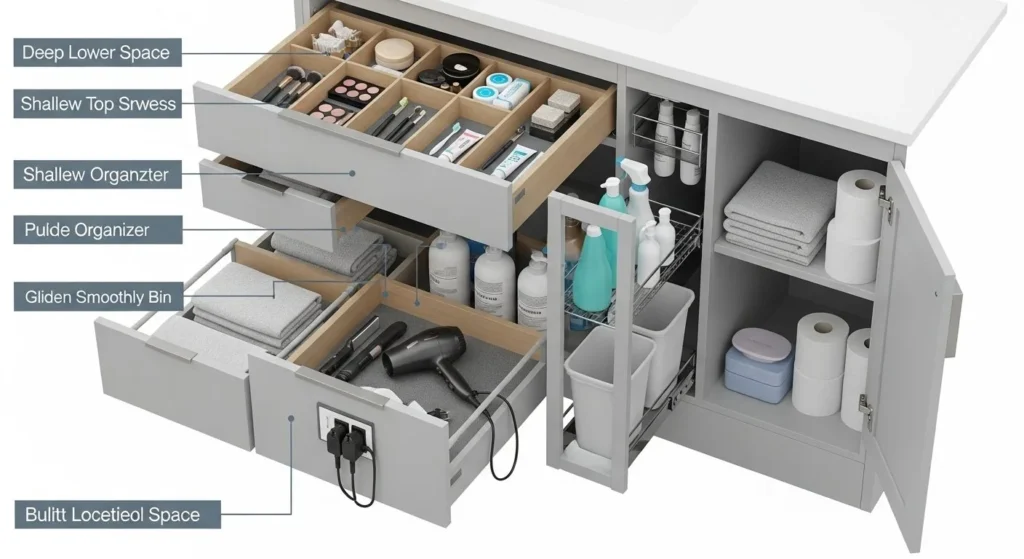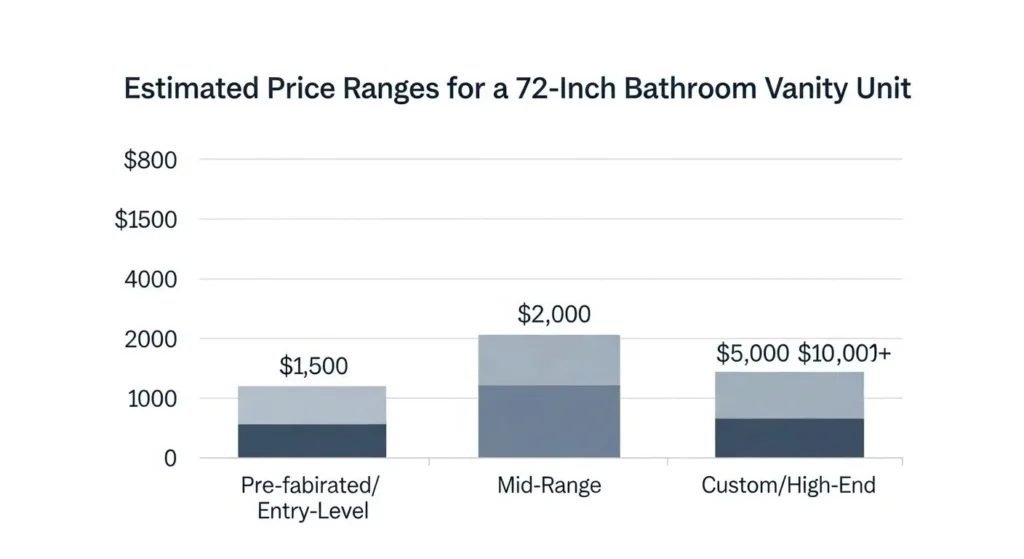Welcome to the world of spacious bathrooms, where a 72-inch bathroom vanity transforms your space. This isn’t just a fixture; it’s a statement piece and a hub of daily activity. As a seasoned professional, I’ve overseen countless installations of these large bathroom vanities over the years. Getting this choice right fundamentally impacts your bathroom’s look and daily utility.
A 72-inch vanity represents a significant investment. My goal is to share hard-won insights to help you avoid common pitfalls and make the best choices for your home. We’ll cover functionality, durability, and aesthetics, all rolled into one comprehensive guide. Indeed, a 72-inch vanity is considered a large vanity, typically accommodating dual sinks, making it perfect for master baths or shared spaces where storage and counter space are paramount.
Choosing the Perfect Style for Your 72-Inch Bathroom Vanity

The impressive size of a 72-inch bathroom vanity means its style will significantly influence your bathroom’s aesthetic. Begin by considering your home’s overall design. Are you aiming for a modern minimalist look with clean lines and flat panel doors, perhaps in a white lacquer or dark walnut finish?
Alternatively, does a traditional design with raised panel doors, ornate hardware, and a distressed oak finish better suit your taste? Transitional styles offer an excellent middle ground, blending classic elements with contemporary touches. I’ve found these to be a popular and versatile choice for many homeowners seeking a balanced aesthetic for their large bathroom vanity.
It is crucial to consider how your chosen vanity style integrates with existing elements like your tile, shower surrounds, and lighting. A 72-inch vanity should not clash with its surroundings; instead, it should enhance them and feel like a natural extension of the room’s character.
The type of door and drawer fronts you select makes a substantial difference in the overall feel. Shaker-style is a timeless choice, versatile enough for many aesthetics, offering a clean look with a touch of traditional detail. For a more contemporary feel, flat panel or slab doors are paramount, providing sleek, uninterrupted surfaces.
Open shelving can add a visual break and a place for decorative towels or baskets. However, be mindful of potential dust and clutter. I recall a project where a client loved their vanity with open shelving but quickly realized they preferred hidden storage for everyday items. It’s a balance between form and function, where personal habits play a significant role in what will truly work for you. Don’t just choose a 72-inch vanity based on a showroom display; visualize how it will function and look in your specific space.
Essential Space Planning for a 72-Inch Vanity Installation

A 72-inch vanity is a substantial fixture, demanding meticulous measurement of your bathroom. Before you commit to a design, ensure adequate clearance around the vanity for door swings, shower doors, and comfortable access to the toilet and other fixtures.
The International Residential Code (IRC) recommends a minimum of 15 inches from the centerline of the toilet to any side wall or obstruction, and 21 inches of clear space in front of the toilet. A 72-inch vanity, being six feet long, requires a wall that can comfortably accommodate it without making the room feel cramped or hindering movement. The standard depth for most 72-inch vanities is typically 21 to 22 inches from front to back, though always check manufacturer specifications.
Beyond the vanity’s footprint, ensure you have sufficient walking space. I consistently recommend at least 30 to 36 inches of clear space in front of the 72-inch vanity for comfortable movement. This is especially vital for a double-sink setup, which is likely to be used by two people simultaneously. Assess whether your existing plumbing lines and electrical outlets are in the correct position for a double-sink vanity.
Relocating plumbing can significantly increase project costs and complexity. If upgrading from a single to a double sink, anticipate reworking at least some of the rough-in plumbing. Wall-mounted vanities, while stylish, require specific wall blocking for secure installation, a detail often overlooked. I’ve encountered projects where walls needed to be opened just to add proper backing for these heavier units, leading to unexpected delays and additional labor costs. Do not skip the structural assessment; it is a critical step in your bathroom vanity installation.
Finally, consider accessibility. Who will primarily use the 72-inch vanity? Comfort height vanities (around 34-36 inches to the countertop) are popular for adults, reducing bending. Standard heights (around 30-32 inches) might be better for children or shorter individuals. Also, think about how drawers and cabinets will be accessed, particularly with a freestanding model where legs might affect toe kick space.
Durable Materials for Your 72-Inch Bathroom Vanity

When investing in a 72-inch bathroom vanity, the materials chosen are paramount for longevity, especially within the high-moisture environment of a bathroom. This is often where many mass-produced vanities fall short in durability.
For the cabinetry, prioritize solid wood construction (such as oak, maple, or birch) or high-quality, furniture-grade plywood for the cabinet box. These materials offer superior resistance to humidity and daily wear. It is best to avoid particle board or standard MDF (medium-density fiberboard), as they tend to swell and degrade quickly with water exposure, leading to structural failures.
If MDF is used, ensure it is a high-density, moisture-resistant grade and that all edges are thoroughly sealed. Dovetail joinery on drawers is an excellent indicator of quality craftsmanship and durability, reflecting attention to detail that extends the life of the 72-inch vanity unit.
For the substantial countertop space on a 72-inch vanity, a wise choice is crucial. My primary recommendation for durability and low maintenance is quartz. It is non-porous, highly resistant to stains, scratches, and chips, making it exceptionally practical for a busy bathroom. Reputable brands like Caesarstone or Cambria offer fantastic patterns that mimic natural stone without the intensive upkeep.
Natural stone options like granite are also incredibly durable but necessitate periodic sealing. Marble, while undeniably beautiful, is porous and susceptible to etching from acidic liquids like toothpaste or spilled perfume. It requires diligent sealing and careful maintenance.
I always caution clients that marble must be treated like fine furniture, not an indestructible surface. A previous client, delighted with their new marble top, found several etch marks within a year from forgotten toothpaste and a bottle of nail polish remover.
Solid surface materials, such as Corian, are non-porous, seamless, and can be repaired if scratched, offering a practical choice, though they may not provide the same luxurious feel as natural stone or quartz. Cultured marble is an economical option, often integrated with the sinks, but it can scratch and dull over time.
Do not overlook smaller details. Soft-close hinges and drawer glides are not merely a luxury; they prevent wear and tear, extending the life of your 72-inch vanity by preventing slamming. Look for quality metal hardware in finishes that complement your bathroom fixtures. A good, multi-coat, moisture-resistant finish on the cabinetry itself is paramount for longevity in a humid bathroom environment, effectively protecting the wood underneath.
Maximizing Storage and Functionality in Your 72-Inch Vanity

A 72-inch vanity provides ample space, and it is crucial to optimize this area for maximum utility. Consider a thoughtful mix of drawers and cabinets to neatly accommodate all your bathroom essentials.
Deep drawers are excellent for storing larger items such as towels, bulky toiletries, or hair styling tools, keeping them organized and out of sight. Shallow drawers positioned near the top are perfect for organizing makeup, smaller accessories, and personal care items, effectively preventing clutter from accumulating on the countertop of your large bathroom vanity.
Many modern 72-inch vanities offer clever features like pull-out organizers or even built-in electrical outlets inside drawers for hair dryers and curling irons. These innovations are truly game-changers for maintaining clear counters and keeping cords out of sight. I always advise clients to inventory their current storage needs and envision how they will use the new space. This foresight helps identify specific storage requirements before committing to a design.
While open shelving can be visually appealing, showcasing decorative items or neatly folded towels, most homeowners find that closed storage is far more practical for managing everyday bathroom clutter. It maintains tidiness, reduces visual noise, and keeps private items discreetly out of sight. A balanced approach might involve a 72-inch vanity with primarily closed storage, perhaps incorporating a small open shelf or cubby for a few chosen display pieces. This design caters to both aesthetics and practicality.
Consider how your 72-inch vanity integrates with your bathroom’s overall storage strategy. Could you add a matching linen tower adjacent to the vanity for extra towel and linen storage? Or perhaps a recessed medicine cabinet above for daily essentials? A well-planned bathroom addresses all storage needs, not solely those directly beneath the countertop.
On a recent project, we designed a custom 72-inch vanity with a clever pull-out cabinet beside the sink specifically for a tall waste bin and cleaning supplies. These small but impactful details significantly enhance daily living and long-term satisfaction.
Budgeting for Your 72-Inch Bathroom Vanity Project

Budgeting for a 72-inch bathroom vanity can be complex due to the incredibly broad price range. You can find pre-fabricated units at big box stores for as little as $800 to $1,500. However, these often come with compromises in material quality, such as particle board construction and cultured marble tops.
Mid-range options, typically featuring better wood construction and more durable quartz or granite tops, usually range from $2,000 to $4,500. For custom or high-end designer 72-inch vanities with specific features and premium materials, expect to spend $5,000 to $10,000 or even more. Remember, these prices often only cover the cabinet and countertop and rarely include sinks or faucets unless specified as a complete package.
Installation costs are frequently underestimated by DIY enthusiasts. Professional installation for a 72-inch vanity can range from $500 to $1,500 or more, depending on the complexity of your specific situation. This typically includes the demolition of the old vanity, area preparation, setting the new unit, plumbing hookups for the sinks and faucets, and potential electrical work for new lighting or outlets.
If you are relocating plumbing lines or adding structural support within the wall, those costs will significantly increase. Always obtain a detailed, itemized quote from your contractor to understand all expenses. I’ve seen clients surprised when moving a drain line added $300-$500 to their plumbing bill alone, so factor this into your initial planning for your 72-inch bathroom vanity installation.
Do not forget to budget for additional expenses that quickly accumulate. You will need sinks (sometimes included, sometimes not), faucets, mirrors, and appropriate lighting fixtures. A quality set of faucets can easily cost $150-$400 per sink. I strongly advise against cutting corners here, as cheap faucets are notorious for leaks, corrosion, and frequent repairs. Mirrors can range from $100 to $500+ each, depending on size and style, and proper lighting (sconces or overhead fixtures) is essential for a functional vanity area.
Finally, account for any necessary wall repairs, paint touch-ups, or new flooring if your old vanity’s footprint was different. These costs add up quickly, so create a comprehensive spreadsheet early in the process to track every potential expenditure for your 72-inch bathroom vanity project.
What is the minimum recommended walking space in front of a 72-inch vanity?
I always recommend at least 30-36 inches of clear walking space in front of any vanity, especially a larger one like a 72-inch vanity. This ensures comfortable movement and accessibility, preventing a cramped feeling in what is often a high-traffic area.
Can I install a 72-inch vanity myself?
While it is possible for experienced DIYers, a 72-inch vanity is heavy and often requires significant plumbing and sometimes electrical work. I strongly recommend professional installation to ensure proper leveling, secure mounting, and correct plumbing connections to avoid leaks and future issues. It is definitely a two-person job, at minimum, given the weight and size.
How do I clean and maintain my quartz countertop on a 72-inch vanity?
Quartz countertops are wonderfully low maintenance. I advise clients to use a mild soap and water solution with a soft cloth for daily cleaning. Avoid abrasive cleaners, harsh chemicals like bleach or oven cleaner, and never use steel wool. Wipe up spills promptly, especially acidic ones, to prevent any potential damage to the surface sealant over time on your 72-inch vanity countertop.
Choosing a 72-inch bathroom vanity is a significant decision, balancing your aesthetic desires with practical, real-world considerations. By focusing on durable materials, thoughtful space planning, and maximizing functionality, you will create a bathroom centerpiece that not only looks great but serves you well for many years to come.
Don’t hesitate to ask questions, thoroughly research your options, and if in doubt, consult with a seasoned professional. Your 72-inch bathroom vanity is an investment in your home’s comfort and style. Make the right choice today for a bathroom you’ll love for decades.




